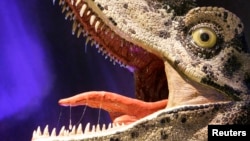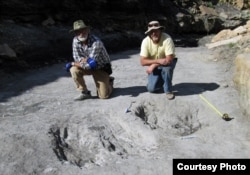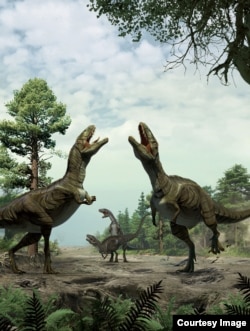Meat-eating dinosaurs, the prehistoric ancestors of modern ground-nesting birds, appear to have engaged in similar mating behavior. An international team studying “scrapes” in the ground said the giant males tried to entice females by exhibiting nest-building behavior.
Four sites of more than 50 scrapes have been discovered in Colorado. Geologist Martin Lockley of the University of Colorado at Denver, who led an international team that studied the scrapes, said some dinosaurs were known to have feathers and crests, but their behavior had been a mystery — until now.
“We actually have the physical evidence; we actually have the display arenas where this took place," he said. "And we can say how big they are and how big the scrapes were, and more or less the size of the dinosaurs that made these things. So this is the first actual physical evidence that confirms what was otherwise previously just speculation.”
By scraping the ground with their feet, Lockley said, male dinosaurs excavated “pseudo” nests in a courting ritual.
“The animal gets excited in the breeding season," he said. "Whether it’s a bird or a dinosaur, it starts scraping to show its mate, 'I know how to build a nest.' And in the excitement, it makes a few scrapes, and that’s enough for that one, and goes on and makes another one and another one. We can see birds doing that. And the bird ancestors, carnivorous dinosaurs, some of them were very big animals and they left scrapes — some of them that were 6 feet long and 5 feet wide.”
Lockley said that only a few small, modern birds now engage in scrape behavior, and those that do go on to build actual nests a short distance away.
The dinosaur scrapes were found in 100-million-year-old sandstone in western Colorado. The large number of them suggests that the area was the prehistoric equivalent of today's singles bars.
The new fossil evidence, described in the journal Scientific Reports, suggests the meat-eaters engaged in early “sexual selection,” an evolutionary driver, in which female dinosaurs selected the most impressive male performers and scrapers as mates.










